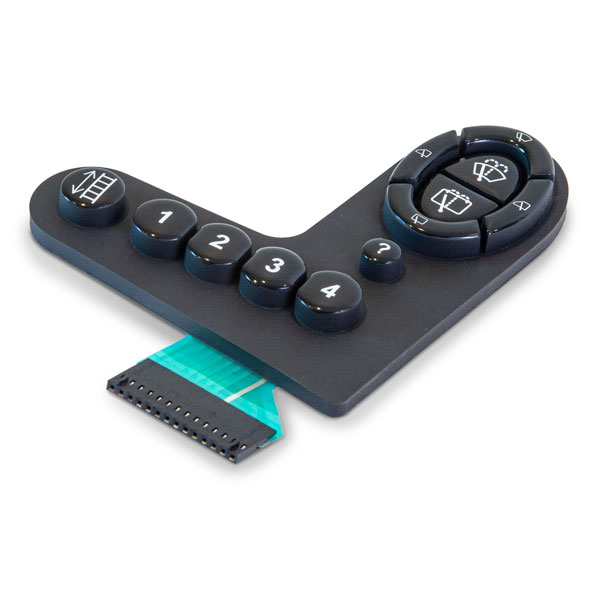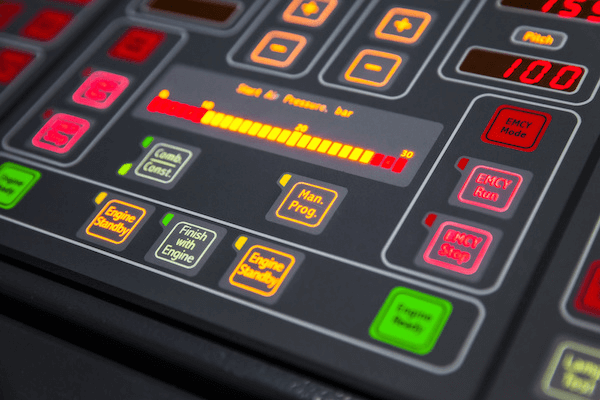The Manufacturing Refine Behind Membrane Layer Change: What You Need to Know
The production process behind membrane changes combines mindful design, product choice, and quality control. It starts with recognizing the details of membrane layer switch layout and advances with various phases, including material selections and printing techniques. Each phase plays a crucial duty in making sure capability and durability. The intricacies of layer construction and the strenuous testing requirements might disclose insights that are not promptly evident. What lies beyond these foundational elements?
Comprehending Membrane Layer Switch Design
Membrane switches may show up straightforward at very first look, their style involves intricate factors to consider that guarantee functionality and resilience. The style process begins with a thorough understanding of user demands, consisting of the interface's desired application and ecological factors. Functional designs is a crucial element, as the design needs to assist in simplicity of usage while guaranteeing that tactile comments meets individual expectations.Moreover, the layering of parts, such as graphic overlays, glue layers, and conductive traces, should be specifically engineered. membrane switch. This layered configuration not only influences the switch's responsiveness but likewise influences its durability. Attention is provided to the securing techniques utilized to shield against moisture and dirt, which might compromise performance. In addition, design factors to consider include aesthetics, where color design and visual clarity boost customer experience. Ultimately, the style of membrane switches equilibriums performance, individual experience, and durability, making sure that they fulfill the needs of various applications properly
Materials Made Use Of in Membrane Change Manufacturing
When picking materials for membrane switch production, it is necessary to consider both efficiency and durability. The primary materials include polyester and polycarbonate movies, which offer adaptability and toughness. These movies are frequently coated with glue to assure appropriate bonding to substrates. Conductive inks, commonly made up of silver or carbon, are vital for creating electric links within the switch, enabling dependable operation.Additionally, a protective layer, such as a difficult coat, is frequently used to enhance scrape resistance and longevity. The option of backing product, such as acrylic or foam, can significantly influence the switch's tactile feel and overall user experience. Moreover, different environmental factors, including temperature level and moisture, should direct product option to assure peak performance in details applications. Inevitably, the right mix of materials adds to the membrane layer button's capability and lifespan, making informed selections important for manufacturers.
The Printing Refine: Creating Video and Text
The printing process in membrane button production plays a significant function in generating top notch graphics and message. Various graphic design methods are used to guarantee aesthetic allure and performance, while mindful ink selection methods are necessary for toughness and efficiency. Comprehending these elements is fundamental for accomplishing ideal cause membrane switch layout.
Graphic Layout Techniques
Graphic layout strategies play an essential duty in the printing procedure of membrane switches, as they specify exactly how graphics and message will eventually appear on the end product. Efficient visuals layout entails the strategic use font styles, shades, and formats to boost readability and aesthetic charm. Developers frequently utilize vector graphics for scalability, ensuring that photos continue to be sharp at different sizes. In addition, interest to comparison and positioning is vital, as it influences customer interaction and visual quality. The unification of branding elements, such as logo designs, must be taken care of with like keep brand stability. On the whole, thoughtful graphic style strategies contribute significantly to the capability and beauty of membrane layer buttons, impacting individual experience and item performance.
Ink Choice Techniques
Picking the appropriate ink is necessary for attaining the desired visual high quality and longevity in membrane switch production. Different ink kinds are made use of, consisting of solvent-based, water-based, and UV-curable inks. Each type uses distinctive characteristics, such as adaptability, attachment, and resistance to environmental elements. Solvent-based inks are often preferred for their longevity and vivid shades, while water-based inks are more ecologically pleasant yet may have limitations in adhesion. UV-curable inks supply quick treating and durable efficiency. In addition, shade matching strategies assure that the selected inks straighten with layout requirements. Ultimately, the choice of ink have to consider factors such as application approach, substratum compatibility, and end-use needs to achieve premium lead to membrane layer button graphics and text.
Layer Construction and Setting Up

Material Selection Process
A cautious choice of products is essential in the manufacturing process of membrane switches, as it directly influences performance and toughness. The key products made use of consist of polyester, polycarbonate, and various conductive inks. Polyester is frequently favored for its outstanding resistance to chemicals and abrasion, making it appropriate for extreme atmospheres. Polycarbonate, on the various other hand, supplies remarkable clearness and effect resistance, which is helpful for applications calling for presence and effectiveness. Conductive inks, normally made up of silver or carbon, are crucial for producing trustworthy electrical pathways. Additionally, the choice of adhesive products influences the general stability of the switch - membrane switch. Evaluating factors such as ecological direct exposure, tactile feedback, and aesthetic needs overviews producers in selecting the very best products for their certain applications
Layer Bond Techniques
Sticking layers in membrane layer switch construction is an essential procedure that guarantees functionality and long life. Different adhesion strategies are utilized to secure excellent bonding in between layers, which generally consist of using adhesives, heat, and stress. Pressure-sensitive adhesives (PSAs) are typically utilized for their convenience of application and instant bonding capacities. Furthermore, thermal bonding techniques can be used, where heat is made use of to trigger glue homes, safeguarding a strong bond. The selection of adhesion approach mainly depends upon the products involved and the particular application demands of the membrane switch. Appropriate alignment and uniform application of adhesives are necessary to stop problems, safeguarding the switch runs efficiently throughout its designated lifespan.
High Quality Control Actions
Guaranteeing top quality control throughout the layer building and setting up of membrane switches is vital for keeping performance and integrity. This process commonly entails several important procedures, including extensive evaluations at each stage of manufacturing. Manufacturers use sophisticated screening approaches, such as peel tests and bond analyses, to validate the integrity of layer bonds. Additionally, visual assessments are performed to recognize any kind of defects in printing or material variances. Ecological problems, such as temperature level and moisture, are meticulously monitored to guarantee perfect curing and adhesion. Routine calibration of devices helps maintain precise manufacturing criteria. By carrying out these quality assurance measures, producers can significantly decrease the risk of product failing, assuring that the final membrane switches fulfill the called for specs and client expectations.
Testing and Top Quality Control Procedures

Developments in Membrane Layer Switch Over Innovation
As developments in technology proceed to progress, membrane buttons are gaining from ingenious developments that boost their performance and user experience. One remarkable advancement is the assimilation of capacitive touch innovation, which enables even more user-friendly and responsive customer interfaces. This shift not just improves aesthetics yet also minimizes mechanical deterioration, expanding the life expectancy of the switches.Additionally, advancements in visuals overlay products have brought linked here about enhanced durability and find this resistance to ecological factors such as wetness and UV light. These products now use enhanced clearness and illumination, further raising the aesthetic appeal.Furthermore, the consolidation of clever technology is transforming membrane layer switches right into interactive control panels, making it possible for connectivity with IoT gadgets. This connection fosters a smooth customer experience, paving the method for applications in numerous industries, from medical care to consumer electronic devices. Jointly, these developments setting membrane layer switches over as vital parts in modern-day device design.
Often Asked Inquiries
How much time Does the Membrane Layer Switch Over Production Process Take?
The duration of the membrane switch manufacturing procedure can differ substantially. Variables such as complexity, materials utilized, and manufacturing quantity impact timelines, with regular manufacturing ranging from a few days to several weeks for completion.
What Are the Common Applications for Membrane Switches?
Membrane switches are frequently used in numerous sectors, consisting of vehicle controls, house devices, clinical tools, and customer electronic devices (membrane switch). Their adaptability and durability make them perfect for applications requiring user-friendly interfaces and reliable performance in varied settings
Can Membrane Layer Changes Be Personalized for Particular Needs?

What Is the Lifespan of a Common Membrane Layer Switch Over?
The lifespan of a typical membrane button varies, but typically, it varies from 1 to 5 million cycles. Variables such as use, environment, and material quality considerably affect longevity and total performance with time.

Are Membrane Switches Eco-friendly?
The ecological kindness of membrane layer changes varies. Some materials used might not be recyclable, while others can be eco-friendly. The total influence depends on manufacturing products and methods, necessitating careful factor to consider throughout choice and disposal. The manufacturing procedure behind membrane layer changes combines careful layout, material selection, and top quality control. It starts with comprehending the intricacies of membrane layer switch design and proceeds with various phases, consisting of material selections and printing methods. When selecting materials for membrane button manufacturing, it is essential to Learn More ponder both performance and durability. A mindful choice of products is necessary in the manufacturing procedure of membrane buttons, as it directly influences capability and sturdiness. The choice of bond method greatly depends on the materials entailed and the particular application needs of the membrane button.
Comments on “An in-depth guide to using membrane switch in automotive control panels”